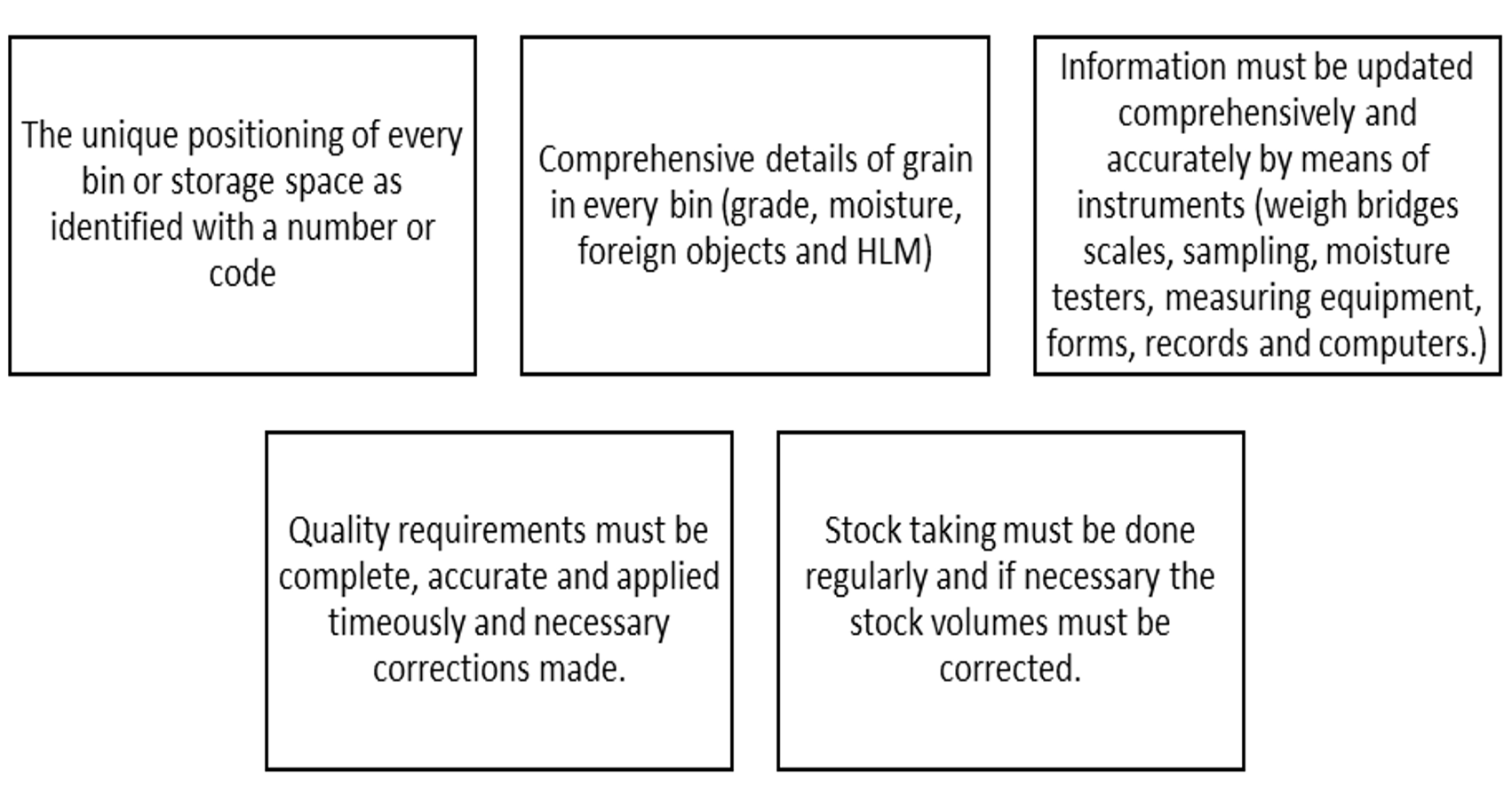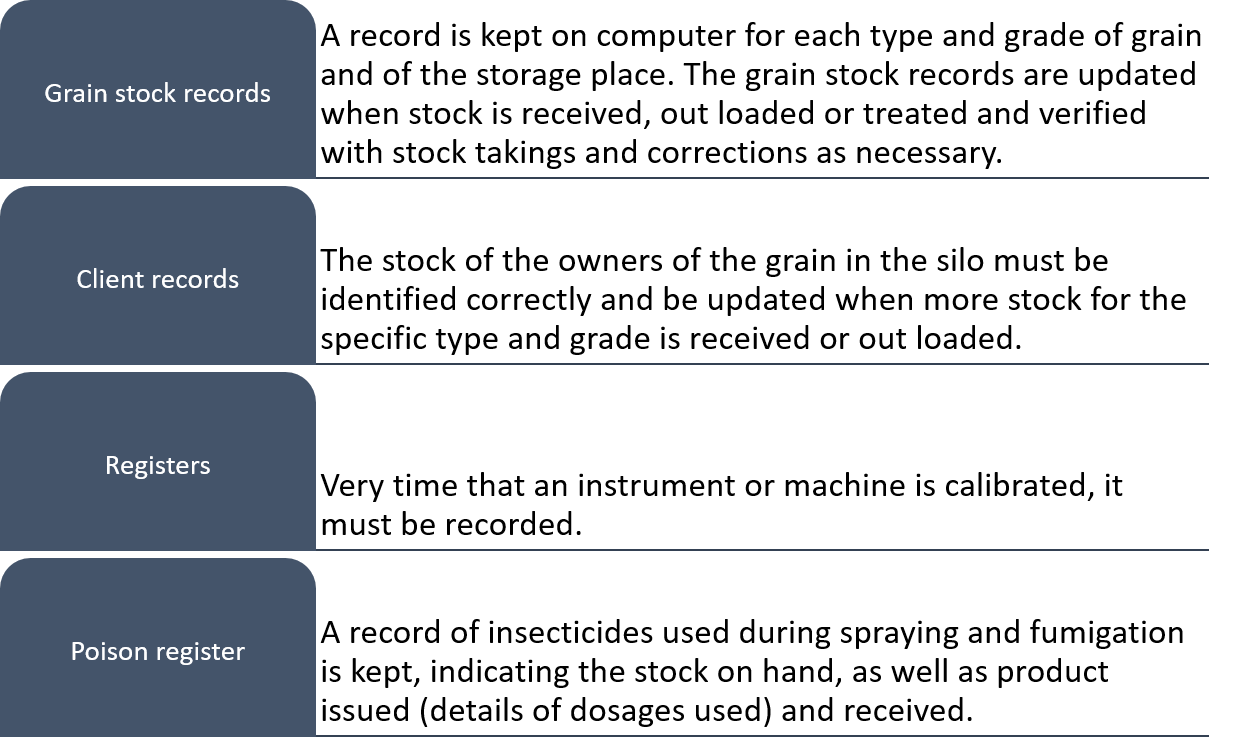Clean Before Fill
Bins should be cleaned before filling with newly-harvested grain. Perforated floors and air ducts also should be cleaned. Spilled and spoiled grain in and around the bins should be cleaned to avoid cross contamination and rodent activity. Spraying insecticides and fungicides inside the cleaned bins will help to eliminate carryover of insect and mould spores from the previously stored grains.
Cool and Dry The Grain
Decrease the grain moisture to the safe storage level and cooling the grain below 15˚C will help to eliminate insect and mold development during storage. Aeration or chilled aeration is the process help to reduce the temperature. Drying process reduces the moisture content. Drying can be done with properly designed systems using either ambient air or heated air.
Turn the Grain Often
Turning the grain inside the bin (moving from one bin to another) brings grain to average temperature inside the bin and eliminates temperature gradients and thus moisture migration.
Clean the Grain
Removing broken seeds, foreign materials and dockages before loading into the bin will help for better air movement inside the bin as well as reduce insect and mold problems. Use of grain spreaders during filling of bins helps in distributing fines more uniformly and thus helps in reducing the risk of localised hot spot development. Use of spreaders however packs the grains thus increasing resistance to airflow and could reduce airflow through grains significantly because airflow output from a fan decreases as static pressure increases.
Avoid Mixing Grain
Mixing newly-harvested grains with the grain already in the bin has potential to create huge temperature and moisture gradients inside the bin and thus leading to increased chances of spoilage.
Monitor Continuously
Regular monitoring of grain moisture and temperature will help to identify the potential hazards on time and take control actions in a proactively. Nowadays various types of temperature sensors, combination of temperature and moisture sensors are available in the market for continuous monitoring of grain bins.
Facility Hygiene Management
To ensure that grain products are safely stored, it is essential that the following hygiene factors must be checked regularly:
- Weeds must be removed from the premises on a regular basis.
- Drainage systems around the building needs to be cleaned.
- Loose product must be removed.
- Sidings and loading areas must be kept clean.
- Waste containers must be emptied weekly.
- Silo bins, stacks, dams, bunkers and silo bags must be neatly stacked and labeled.
- Remove birds’ nests regularly.
- Dust extraction points/pipes often clog and are a source of contamination throughout the facility. The regular cleaning of the pipes and cyclone is therefore extremely important.
- Grading equipment must be cleaned properly after the season has ended.
- Cleaning machines is the first part of the product handling function and should be cleaned regularly.
- Intake hoppers/discharge hoppers is one of the largest sources of infestation and should thus be cleaned on a daily basis.
- Mass meters should be inspected and cleaned on a regular basis.
- Screening tests should be done weekly. Inspect each silo bin at the top inlet cover for insects and condensation. Pay particular attention to any musty and/or sour smells at the top of the silo bin. Determine the temperature at the top of the silo bin. Look in the tunnel for traces of insects on the conveyor belt before the belt is started. Sift each outlet valve and look for insects. The workhouse, dryer, dust extraction apparatus and offload hoppers are often overlooked during the inspection. Record findings of the entire silo complex and not only the infestation that occurs in the silo bin.
Regular Monitoring
Examinations are essential if mould and insect activity are to be detected and controlled in a timely fashion. The method and frequency of checking will vary with time of year, initial grain condition, and aeration procedure. Generally, grain should be inspected at least once a month during the winter and every two weeks at other times of the year.
Extreme caution should be exercised when checking grain. Bridged grain is very dangerous, and collapse of the bridged area can result in suffocation. Always use a safety harness, lifeline, and grab rope, and have a second person outside the bin to assist in case of an emergency.
Monitoring grain condition is extremely important during the summer because grain is held at higher temperatures and aeration conditions are less favorable. Grain temperatures should be checked and recorded at least every two weeks. Without records, it is difficult to tell whether elevated temperatures are caused by normally occurring outside temperatures or by heating due to mold activity. Use a grain probe to locate any moisture pockets where molds will develop rapidly as temperatures warm.
Insect activity is also at a peak during the summer, and frequent checking is required if infestations are to be controlled before they develop into major problems.
Failure to monitor grain condition throughout the entire storage period is a frequent mistake. A small area that starts to heat or otherwise "go out of condition" can quickly get out of control and spread within the bin. Think of the grain as being cash in the bin and consider how frequently it would get checked if that were the case.
Some areas and conditions to check when monitoring grain quality include:
- Grain surface for condensation, crusting, wet areas, molds, and insects.
- Bin roof for condensation and leaks.
- Grain mass for non-uniform temperatures, high moisture pockets or layers, molds, and insects.
- Exhaust air for any off-odours.
- If problems are detected, they need to be evaluated and corrected as soon as possible. This may include cooling with aeration, further drying, or fumigation for insect control.
Click here to view a video that explains grain storage insect identification.
Click here to view a video that explains grain silo hygiene.
Stock Control
Both the quantity of different types and grades of grain must be controlled, as well as the quality thereof. The quantity of grain will change each time grain is received or out-loaded. At times, these quantities will be verified by stock taking. The quality of grain must receive continuous attention because it could be affected at any stage if it becomes dirty, wet or contaminated.
The control of the quality of grain therefor includes all the procedures to ensure it, including intake, cleaning, drying, fumigation, as well as cleaning and repair of bins and storage hygiene.
The control of stock at the grain depot is important for the following reasons:

In order to be effective, a system of stock control should comprise the following components:

The stock on hand is kept on record on the silo computer system and is compared with the physical stock measured with a measuring tape, laser (ultrasonic instrument) and a torch. Differences are investigated and resolved. Old stock must possibly be written off. Stock taking is done at regular intervals (weekly, monthly) and at the end of the financial year.
Precautionary measures that must be taken with stock taking:

Possible reasons for differences between physical stock and book value of stock:

It is important that permanent records are kept and updated. The records are noted in registers (such as poison registers or calibration tests of scales and instruments) or kept on computer.
Examples of Record are:
::